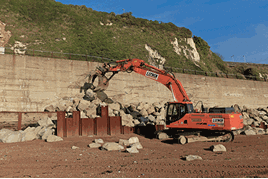Christmas time is usually memorable for the obvious reasons… food, presents and time off with family. But Christmas Eve 2015 and the days that followed will be remembered by Network Rail’s teams in Dover as the day the sea wall became forced apart, succumbing to the raw power of the English Channel.
As RAIL’s recent news coverage has shown, storm damage over the festive period was not simply confined to this short stretch of beach on the South Coast (RAIL 792). The impact of the storms of December 2015 and January 2016 was keenly felt across the entire UK rail network, saturated by record rainfall and widespread flooding.
The flood damage sustained at Lamington Viaduct on New Year’s Eve would quickly overshadow events at Dover, as it came so perilously close to collapse, shutting the arterial West Coast Main Line north of Carlisle.
The South Eastern Main Line at Dover is a comparative backwater. And it is one of two routes crossing the county of Kent, so at least the citizens of Dover and the surrounding villages therefore have an alternative route to London via Canterbury, albeit with some time penalty.
But Lamington has now re-opened, leaving Dover and ground instability on the Settle-Carlisle Line as the two outstanding major recovery works for Network Rail, after a particularly challenging winter.
The first reports that things were amiss at Dover came at 1020 on December 24 2015, when operator Southeastern tweeted that one of the two tracks had been closed above Shakespeare Beach for safety checks. By 1100 it had become clear that the still-rough seas had fundamentally undermined the sea wall, and both lines were duly shut before NR’s on-call engineers were given their summons.
“I got a phone call on Christmas Eve, after the track inspection team noticed a crack in the sea wall and a noticeable dip,” says NR Senior Programme Manager Steve Kilby. “We obviously stopped the trains, and our asset engineers did a rapid inspection revealing a section of the wall was broken, kicking off a significant voiding issue.”
What the track inspectors had noticed were large cracks along a 150-metre section of the wall supporting the railway, near to where it emerges from Shakespeare Cliff Tunnel on its final approach into Dover. Behind the cracks sinkholes had appeared two to three metres deep, taking ballast and other lineside equipment with them as seawater penetrated deep within.
Resulting in scenes reminiscent of the sea wall collapse at Dawlish two years ago, Network Rail is in no doubt about what caused this serious breach of a concrete structure that had hitherto withstood all before it for almost 90 years.
“I have observed over time spent at Dover that the beach volume will sometimes drop 1.5 metres over the daily cycle of two tides,” adds Kilby. “In the run-up to Christmas this was over two metres, exposing the foot of the wall. Instead of spray hitting the wall like normal, we’ve had green water. The tide was 6.7 metres that day, which had a double impact over both tides.”
Other than the pounding action of heavy seas being responsible for both the sea wall breaches at Dawlish and Dover, Kilby says that this is where the similarities end.
At Dawlish an 80-metre hole was punched in the sea wall on February 4 2014, closing the main line between Exeter and Newton Abbot and cutting off Cornwall from the rest of the UK rail network.
Also in the case of Dawlish, shipping containers were put in front of the damaged sea wall before the sub-soil behind it could be eroded, allowing repair work to start quickly. The line was re-opened on April 4 after a closure period of just eight weeks.
At Dover, services have already been suspended for approximately ten weeks. And as this issue of RAIL went to press, NR was still unable to give a fixed date for re-opening until designs can be completed for a permanent repair.
“This is much worse than at Dawlish,” explains Kilby. “At Dawlish the top of the wall failed, so they had a solid base to work from. Here we have a 150m hole that is 10m high, and the foundations have been washed away. The wall’s back is broken.
“We have nothing to build on, so this is very much worse. But we have spoken to the team that worked on Dawlish, we are working with the same designers, and are benefiting from shared expertise.”
















Login to comment
Comments
FrankH - 22/08/2016 22:32
Due to re open Monday September 5th, 3 months ahead of schedule.